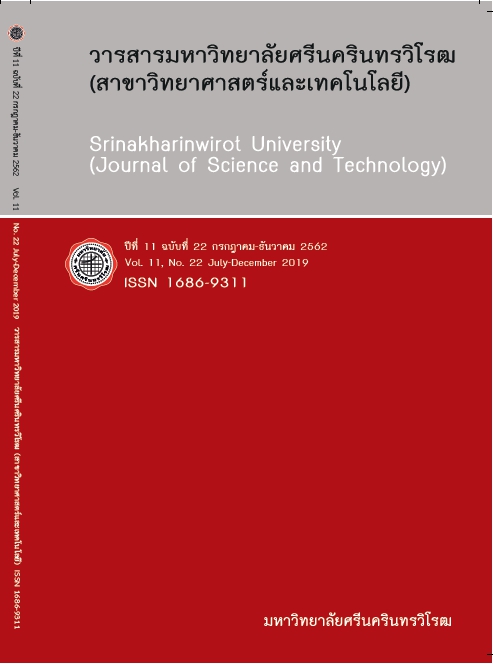การลดการปลดปล่อยก๊าซเรือนกระจกจากกรรมวิธีการใช้ปุ๋ยต่างกันร่วมกับซีโอไลต์ 4 เอ (REDUCTION OF GREENHOUSE GAS EMISSIONS FROM DIFFERENT FERTILIZER USES WITH ZEOLITE 4A)
Keywords:
Greenhouse Gas, Zeolite, Reduction Rate Of Emission, GHG EmissionAbstract
The objective of this investigation aims to study the feasibility of reducing greenhouse gas (GHG) emission with zeolite 4A. The experiment was designed in 4 main plots with different fertilizer application methods such as (I) control plot with no fertilizer added, (II) a single chemical fertilizer added plot, (III) two times of chemical fertilizers added plot and (IV) slow released chemical organic fertilizer added plot. Subplots were as zeolite 4A added in 3:1 ratio of zeolite and fertilizer and no zeolite added. RD 41 rice variety was cultivated at the rate of 25 kg/rai in Lam Ta Khong research station, Nakhon Ratchasima. The chemical fertilizers used were 16-20-0 and 46-0-0 at a rate of 50 kg/rai after sowing 20 days and 60 days. The experimental results showed that the GHG emission of 4 main plots were significantly different. It demonstrated that zeolite 4A could reduce the GHG emission. The reduction rate of GHG emission per zeolite was in the range of 0.97-35.49 gCO2 equivalents/m2-g zeolite. A single chemical fertilizer added plot had the highest percentages of reducing GHG emission, but the slow released chemical organic fertilizer added plot had the lowest percentage of reducing GHG emission. Zeolites have highly the cation exchange capability, so it absorbs minerals in its pore by chemical adsorption. Besides, the structure of the zeolite is highly porous. It can absorb methane and carbon dioxide gas in its gap. Therefore, zeolite serves as both a mineral adsorbent and gas absorber. It concluded that the reduction efficiency of GHG emission depended on both the amount of fertilizer used and GHG emissions.
Downloads
References
[2] Applied Economics Research Center, Faculty of Economics, Kasetsart University. (2010, September). National Report No. 2 for UNFCCC. Office of Natural Resources and Environmental Policy and Planning, Ministry of Natural Resources and Environment.
[3] Mungkung, R., Gheewala, S., Poovaroodom, N., and Towprayoon, S. (2010). Carbon Footprint and Carbon Label of Rice. The Thailand Research Fund. pp. 1-83.
[4] Graduate School of Energy and Environment. (2010). Full Report on Greenhouse Gas Inventories in Thailand. King Mongkut's University of Technology Thonburi. Bangkok: Office of Natural Resources and Environmental Policy and Planning.
[5] Kanchanasunthon, R. (1994). Effects of Farming and Field Farming on Methane Emission in Chiang Mai Province. Master of Science Thesis Chulalongkorn University.
[6] Photyothin, W. (2000). Effect of Rice Varieties on Methane Emission in Ratchaburi Province by Applying Geographic Information System. Master of Science Thesis King Mongkut's University of Technology Thonburi.
[7] Rakharuthai, W. (2003). Methane Emission from Agricultural Areas. Master of Science Thesis Chulalongkorn University.
[8] Wanichpongpan, P. (1993). Emission and Factors Influencing the Methane Emission from Paddy Fields. Master of Science Thesis, King Mongkut's University of Technology Thonburi.
[9] Torii, K. (1978). Utilization of natural zeolite in Japan, in “Natural Zeolites: Occurrence, Properties, Use”. Pergamon Press, Elmsford, New York, pp. 441-450.
[10] Butorac, A., Filipan, T., Basic, F., Butorac, J., Mesic, M., Kisic, I. (2002). Crop response to the application of special natural amendments based on zeolite tuff. Rostlinná Výroba. 48, 118-124.
[11] Kamarudin, K. S. N., Hamdan, H., and Mat, H., (2003). Methane adsorption characteristic dependency on zeolite structures and properties. The 17th Symposium of Malaysian Chemical Engineers.
[12] Breck, Donald W. (1974). Zeolite Molecular Sieves: Structure, Chemistry, and Use. Wiley Publisher.
[13] Sansupan, Y. (1998). Adsorption isotherms of concentrated hydrocarbon gases on zeolites. Thesis Master of Engineering. Chulalongkorn University.
[14] Indonesian Center for Agricultural Land Resources Research and Development (ICALRD). (2010). Greenhouse Gas Emission under Different Crop Management Practices in Indonesia. Retieved from http://www.niaes.affrc.go.jp/marco/marco_gra2010/07_marco_gra_setyanto.pdf
[15] Wang, J.Z., Hu, Z.Y., Zhou, X.Q., An, Z.Z., Gao, J.F., Liu, X.N., Jiang, L.L., Lu, J., Kang, X.M., Li, M., Hao, Y.B., Kardol, P. (2014). Effects of Reed Straw, Zeolite, and Superphosphate Amendments on Ammonia and Greenhouse Gas Emissions from Stored Duck Manure. Journal of Environmental Quality. 4, 1221-1227.
[16] The Thailand Research Fund (TRF). (2019). Reduction greenhouse gases in argicultural sector. TRF policy brief. TRF Policy Brief. 3(8)/2012. Retrieved from http://prp.trf.or.th/trf-policy-brief
[17] Jahmori, M. F., Liang, J. B., Rosfarizan, M., Goh, Y. M., Shokryazdan, P., and Ho, Y. W. (2011). Efficiency of Rice Straw Lignocelluloses Degradability by Aspergillus terreus ATCC 74135 in Solid State Fermentation. African Journal of Biotechnology. 10(21): 4428-4435.
[18] Natpinit, P., Anuwattana, R., Ditkaew, T., and Suppinunt, T. (2016). Application of Rice Stubble Synthesized Zeolite for Greenhouse Gas Reduction. App. Envi. Res. 38(2), 23-31.
[19] Guangzhou Chemxin Environmental Material Co.,Ltd. (2019). 4A Molecular sieve specifications. Retrieved from ttp://www.chemxin.com/product/class/68.html
[20] Tangkuliboon, R., Tangworntharama, P., Roongkra, P., Bamrungsuk, P. and Bunyot, P. (2016). Research and Development of Slow-Released Fertilizer Products. In Final Report. Thailand Institute of Scientific and Technological Research.
[21] Bureau of Soil Resources Research, Department of Land Development, Ministry of Agriculture and Cooperatives. (2019). Characteristics and properties of northeastern soil series: Korat soil series. Retrieved from http://oss101.ldd.go.th/web_thaisoils/pf_desc/northeast/Kt.html
[22] Dubey, S.K. (2001). Methane Emission and Rice Agriculture. Current Science. 81, 345-346.
[23] IPCC. (1995). IPCC Second Assessment Report: Climate Change 1995. Retrieved from https://www.ipcc.ch/pdf/climate-changes-1995/ipcc-2nd-assessment/2nd-assessment-en.pdf
[24] Wong, T. W. (2009). Handbook of zeolites: Structure, properties and applications. Nova Science Publishers.
[25] Shashoua, Y. (1996). Zeolites. Retrieved from http://cool.conservation-us.org/byorg/abbey/an/an20/an20-7/an20-702.html
[26] Polat, E., Karaca, M., Demir, H., and Naci-Onus, A. (2004). Use of natural zeolite Clinoptilolite) in agriculture. Journal of Fruit Ornamental and Plant Research. 12, 183-189.
[27] Aulakh, M.S., and Singh, B. (2000). Methane Emissions from Rice Fields-Quantification, Mechanisms, Role of Management, and Mitigation Options. Advances in Agronomy. 70, 193-260.
Downloads
Published
How to Cite
Issue
Section
License
Srinakharinwirot University Journal of Sciences and Technology is licensed Under a Creative Commons Attribution-NonCommercial-NoDerivs 4.0 International (CC-BY-NC-ND 4.0) License, Unless Otherwise Stated. Please Read Journal Policies Page for More Information on Open Access, Copyright and Permissions.



